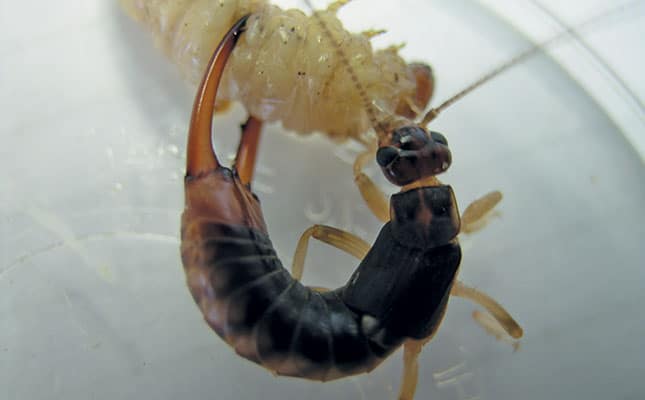
Photo: Dr Annemie Erasmus
Naturalist and co-founder of the EO Wilson Biodiversity Foundation in the US, Edward Wilson, once said, “If insects were to vanish, the environment would collapse into chaos”.
According to Dr Annemie Erasmus, researcher in entomology at the ARC Grain Crops Institute (ARC-GCI), crop farmers who see all insects on their lands as pests to be eradicated would do well to heed Wilson’s words. These farmers are likely to find that, on closer examination, many of these insects are benefical predators that attack destructive pests.
Restoring biodiversity
There is an urgent need for local crop farmers to restore insect biodiversity in agriculture, Erasmus stresses.
A diverse range of flora in a crop land serves to confuse or deter crop-damaging insects, as these pests can land inadvertently on non-host plants.
“If the insect lands on a non-host plant, it wastes valuable time and energy on this plant and, at the same time, is exposed to its natural enemies. During its search for a host plant, the insect pest may even become trapped in an undesirable environment and ultimately die.
“The variety of host and non-host plants on a land could also confuse an insect pest to the extent that it simply exits the land,” Erasmus explains.
The importance of land margins
A 2015 study conducted by Monique Botha of North-West University’s Unit for Environmental Sciences and Management found that margins of natural veld between the crop and the field boundary played a significant role in enhancing the biodiversity of arthropods, including insects, in and around maize lands. While arthropod biodiversity was lower in the maize lands, margins up to 30m from the last crop row had insect diversity comparable to pristine grassland.
Furthermore, Botha’s research found that just 0,0001% of insects discovered during this study caused damage to the maize crops!
The study found an average of 17 plant species growing on the maize lands surveyed, and that a total of 820 plant species were growing in close proximity to the various maize lands, or within the 30m margins around these lands.
Botha concluded that although crop farming resulted in decreased insect abundance inside crop lands, such activities did not decrease insect biodiversity outside the crop lands.
Push-Pull Strategy
“South Africa’s crop farmers can also use their land margins to deliberately implement conservation biocontrol using push-pull strategies against insect pests. Unfortunately, it seems that very few of our commercial crop farmers use these strategies,” Erasmus says.
Push-pull strategies for insect pest management were developed by Prof Zeyaur Khan of the International Centre of Insect Physiology and Ecology in Kenya. In his paper ‘Push-Pull Strategy for Insect Pest Management’ Khan says that a novel tool for integrated pest management programmes uses a combination of behaviour-modifying stimuli to manipulate the distribution and abundance of insect pests and natural enemies.
In this strategy, pests are repelled or deterred away from the main crop (push) by using stimuli that mask host apparency. The pests are simultaneously attracted (pull) with highly apparent and attractive stimuli to other areas such as traps or trap crops where they can be controlled.
Implementing push-pull on a land
Erasmus provides a practical example of a push-pull strategy: planting a primary crop such as maize, a secondary crop such as a Desmodium species between the rows of the primary crop, and a third crop such as vetiver/napier grass on the edges of the land.
“Volatile chemicals given off by the Desmodium repel stem borer moths. Being a legume, Desmodium also fixes atmospheric nitrogen in the soil. This plant also helps to inhibit the growth of weeds, such as parasitic striga.
“The repelled stem borer moths are then attracted to the vetiver/napier grass around the maize land, and lay their eggs on this grass. The resultant moth larvae cannot feed on the tough vetiver/napier grass, so they starve to death. This significantly reduces stem borer populations and the damage that they cause to maize and other primary crops.”
Conservation agriculture
“The question remains whether or not conservation agriculture (CA) practices can contribute to restoring insect biodiversity,” says Erasmus.
The ARC-GCI is currently conducting trials to determine which insects offer beneficial ecosystem services to crop farmers. Preliminary results have found that in lands where CA was practised, there was 75% predation of cutworms compared with 25% in conventionally tilled lands.
“When some predatory insects run out of damage-causing insects to feed on in crop lands, [they] start consuming weed seeds in the lands. Results from a field trial on consumption of weed seeds by beneficial insects showed that, in CA lands, these insects consumed 5% of the weed seeds, compared with 2,5% consumed by beneficial insects in conventionally tilled crop lands,” says Erasmus.
Research by the ARC-GCI has also found that insect pests are significantly more prevalent in conventionally tilled crop lands than in CA crop lands.
“Conservation agriculture supports biodiversity, and the healthier the biodiversity, the more stable the agro-ecosystem,” Erasmus says.
This presentation was given at the No-Till Club’s 2016 Conservation Agriculture Conference.
Phone Dr Annemie Erasmus on 018 299 6113, or email [email protected].













